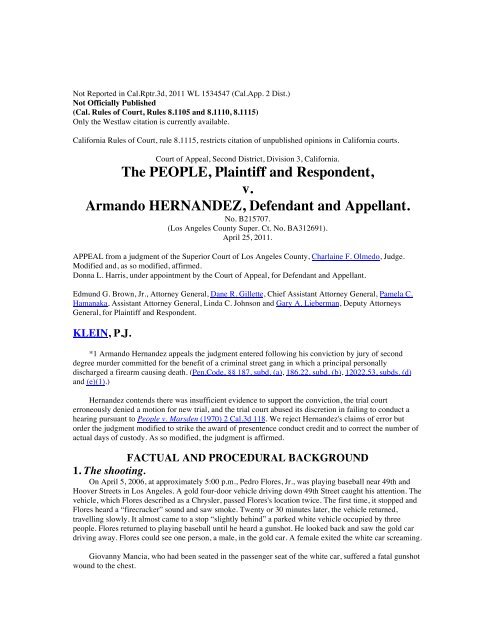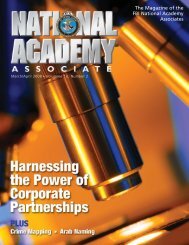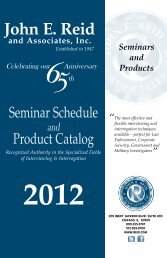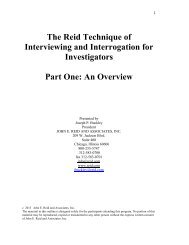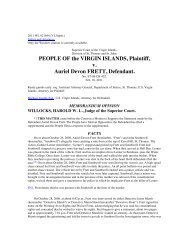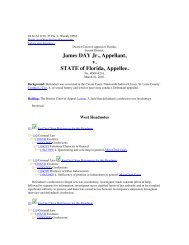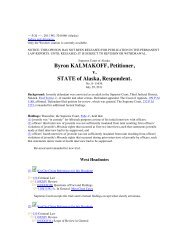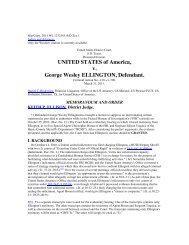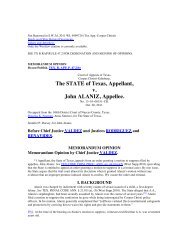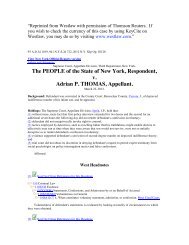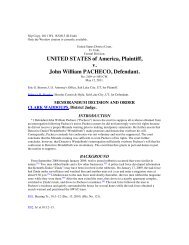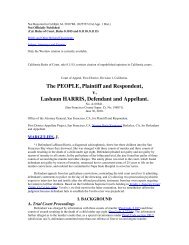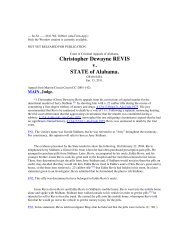The PEOPLE Plaintiff and Respondent v Armando HERNANDEZ Defendant and Appellant
Hernandez case - Leo rejected - The Reid Technique of interviewing ...
Hernandez case - Leo rejected - The Reid Technique of interviewing ...
- No tags were found...
Create successful ePaper yourself
Turn your PDF publications into a flip-book with our unique Google optimized e-Paper software.
Not Reported in Cal.Rptr.3d, 2011 WL 1534547 (Cal.App. 2 Dist.)<br />
Not Officially Published<br />
(Cal. Rules of Court, Rules 8.1105 <strong>and</strong> 8.1110, 8.1115)<br />
Only the Westlaw citation is currently available.<br />
California Rules of Court, rule 8.1115, restricts citation of unpublished opinions in California courts.<br />
Court of Appeal, Second District, Division 3, California.<br />
<strong>The</strong> <strong>PEOPLE</strong>, <strong>Plaintiff</strong> <strong>and</strong> <strong>Respondent</strong>,<br />
v.<br />
Arm<strong>and</strong>o <strong>HERNANDEZ</strong>, <strong>Defendant</strong> <strong>and</strong> <strong>Appellant</strong>.<br />
No. B215707.<br />
(Los Angeles County Super. Ct. No. BA312691).<br />
April 25, 2011.<br />
APPEAL from a judgment of the Superior Court of Los Angeles County, Charlaine F. Olmedo, Judge.<br />
Modified <strong>and</strong>, as so modified, affirmed.<br />
Donna L. Harris, under appointment by the Court of Appeal, for <strong>Defendant</strong> <strong>and</strong> <strong>Appellant</strong>.<br />
Edmund G. Brown, Jr., Attorney General, Dane R. Gillette, Chief Assistant Attorney General, Pamela C.<br />
Hamanaka, Assistant Attorney General, Linda C. Johnson <strong>and</strong> Gary A. Lieberman, Deputy Attorneys<br />
General, for <strong>Plaintiff</strong> <strong>and</strong> <strong>Respondent</strong>.<br />
KLEIN, P.J.<br />
*1 Arm<strong>and</strong>o Hern<strong>and</strong>ez appeals the judgment entered following his conviction by jury of second<br />
degree murder committed for the benefit of a criminal street gang in which a principal personally<br />
discharged a firearm causing death. (Pen.Code, §§ 187, subd. (a), 186.22, subd. (b), 12022.53, subds. (d)<br />
<strong>and</strong> (e)(1).)<br />
Hern<strong>and</strong>ez contends there was insufficient evidence to support the conviction, the trial court<br />
erroneously denied a motion for new trial, <strong>and</strong> the trial court abused its discretion in failing to conduct a<br />
hearing pursuant to People v. Marsden (1970) 2 Cal.3d 118. We reject Hern<strong>and</strong>ez's claims of error but<br />
order the judgment modified to strike the award of presentence conduct credit <strong>and</strong> to correct the number of<br />
actual days of custody. As so modified, the judgment is affirmed.<br />
FACTUAL AND PROCEDURAL BACKGROUND<br />
1. <strong>The</strong> shooting.<br />
On April 5, 2006, at approximately 5:00 p.m., Pedro Flores, Jr., was playing baseball near 49th <strong>and</strong><br />
Hoover Streets in Los Angeles. A gold four-door vehicle driving down 49th Street caught his attention. <strong>The</strong><br />
vehicle, which Flores described as a Chrysler, passed Flores's location twice. <strong>The</strong> first time, it stopped <strong>and</strong><br />
Flores heard a “firecracker” sound <strong>and</strong> saw smoke. Twenty or 30 minutes later, the vehicle returned,<br />
travelling slowly. It almost came to a stop “slightly behind” a parked white vehicle occupied by three<br />
people. Flores returned to playing baseball until he heard a gunshot. He looked back <strong>and</strong> saw the gold car<br />
driving away. Flores could see one person, a male, in the gold car. A female exited the white car screaming.<br />
Giovanny Mancia, who had been seated in the passenger seat of the white car, suffered a fatal gunshot<br />
wound to the chest.
2. Hern<strong>and</strong>ez's statements to the police.<br />
Investigation of the shooting by Los Angeles Police Detective Peter Stone led to a gold Toyota Camry<br />
registered to Hern<strong>and</strong>ez. On November 15, 2006, seven months after the shooting, Hern<strong>and</strong>ez was arrested<br />
driving the Camry at 7:30 a.m. Hern<strong>and</strong>ez was taken to the 77th Street Station where he waived his rights<br />
under Mir<strong>and</strong>a v. Arizona (1966) 384 U.S. 436 [16 L.Ed.2d 694]. Detective Stone <strong>and</strong> his partner,<br />
Detective Joseph Chavez, interviewed Hern<strong>and</strong>ez several times on November 15, 2006, for a total of less<br />
than five hours. <strong>The</strong> first interview started at 10:30 a.m. <strong>and</strong> lasted approximately half an hour. A second<br />
interview lasted a similar amount of time. After lunch, Hern<strong>and</strong>ez was transported to Parker Center. <strong>The</strong><br />
detectives commenced an interview of Hern<strong>and</strong>ez at 2:00 p.m. that included long breaks. <strong>The</strong> tape<br />
recording of the interview <strong>and</strong> the breaks is two hours <strong>and</strong> 42 minutes long. During the interviews at the<br />
77th Street Station <strong>and</strong> the first interview at Parker Center, Hern<strong>and</strong>ez denied involvement in the shooting.<br />
<strong>The</strong> next interview started at about 5:00 p.m. <strong>and</strong> lasted approximately one hour. In this interview,<br />
Hern<strong>and</strong>ez eventually stated fellow gang members Rascal <strong>and</strong> Flaco were in Hern<strong>and</strong>ez's car on the day of<br />
the shooting <strong>and</strong> that Rascal was in the front passenger seat. Hern<strong>and</strong>ez stated, “Deep down, I never circled<br />
the block. And if I gave a ride to that motherfucker that killed him, it was my mistake for letting those other<br />
fools jump into my car.” Hern<strong>and</strong>ez stated, “I mean, for me, I wasn't with them, but there could be a big<br />
chance that I gave them a ride.”<br />
*2 In a portion of the interview played for the jury, Hern<strong>and</strong>ez said the shooting was not planned but<br />
was committed because the victim “was a rival gang member” <strong>and</strong> there had been graffiti written in the<br />
neighborhood by individuals from “the other side.” <strong>The</strong> shooting was committed by Flaco, a “youngster,”<br />
who had a gun “on him.” Hern<strong>and</strong>ez indicated the shooting occurred while he was taking Rascal home.<br />
Hern<strong>and</strong>ez told the detectives, “Homie just got out <strong>and</strong> fired.”<br />
Hern<strong>and</strong>ez then returned to his original story <strong>and</strong> said, “I just wasn't there. I just didn't do this.”<br />
Hern<strong>and</strong>ez claimed he was “just telling [the detectives] what Rascal told [him].” However, as the detectives<br />
prepared to complete the booking process, Hern<strong>and</strong>ez stated he wanted to tell them “the full story.”<br />
<strong>The</strong> final interview started at 8:00 or 9:00 p.m. <strong>and</strong> a tape recording of it was played for the jury. In<br />
the interview, Hern<strong>and</strong>ez stated he drove past Rascal's house, saw Rascal in front of the house <strong>and</strong> stopped<br />
to talk to him. Hern<strong>and</strong>ez agreed to drive Rascal to the home of a female who lived behind Hern<strong>and</strong>ez's<br />
home. Rascal got into the front passenger seat <strong>and</strong> a younger individual, Flaco, got into the rear seat. All<br />
three of them were members of the gang ATC. After learning the female was not home, they drove around<br />
the block. Hern<strong>and</strong>ez intended to take Flaco home. Rascal saw “the two little guys <strong>and</strong> the girlfriend.”<br />
Rascal said, “What? Who's those fools?” When Hern<strong>and</strong>ez said he did not know, Rascal said, “Hold on,”<br />
<strong>and</strong> got out of the car. Before exiting the car, Rascal said, “Let's fuck them.” Hern<strong>and</strong>ez assumed Rascal<br />
was going to commit a robbery <strong>and</strong> claimed he did not know Flaco had a gun. Rascal <strong>and</strong> Flaco got out of<br />
the car <strong>and</strong> Hern<strong>and</strong>ez continued driving “up <strong>and</strong> away from them. Next thing I know, I just heard one<br />
shot.” Hern<strong>and</strong>ez indicated he knew the victim was from M.S. Hern<strong>and</strong>ez said, “little homie smoked him.”<br />
After Hern<strong>and</strong>ez heard the shot, Rascal returned to the car <strong>and</strong> told Hern<strong>and</strong>ez to leave. Hern<strong>and</strong>ez was<br />
upset they had committed a shooting so close to his home <strong>and</strong> asked, “What the fuck?” Hern<strong>and</strong>ez drove<br />
them to Rascal's house <strong>and</strong> then went home. Hern<strong>and</strong>ez indicated he often had told Rascal to leave his gun<br />
at home but Rascal called him “a little bitch.”<br />
When Detective Chavez asked if Hern<strong>and</strong>ez ever found an expended casing in his car, Hern<strong>and</strong>ez<br />
indicated that, on another occasion sometime after February 5, Hern<strong>and</strong>ez <strong>and</strong> Rascal were following a<br />
small red car at Exposition Boulevard <strong>and</strong> Vermont Avenue <strong>and</strong> Rascal produced a “little .25 <strong>and</strong> shot<br />
those fools up....” However, Hern<strong>and</strong>ez never found a casing in the car.<br />
On the day of Hern<strong>and</strong>ez's arrest, Detective Stone conducted a search of Hern<strong>and</strong>ez's home, which is<br />
approximately 150 yards from the scene of the shooting. In a room separate from the house at the rear of<br />
the property, Stone found Hern<strong>and</strong>ez's driver's license, bullets <strong>and</strong> a CD holder with gang writing on it.<br />
3. Evidence related to the criminal street gang enhancement.
*3 On April 6, 2003, Inglewood police officers went to a restaurant on Manchester Boulevard in<br />
response to a v<strong>and</strong>alism complaint. <strong>The</strong> officers found Hern<strong>and</strong>ez sitting in a gold Toyota Camry. <strong>The</strong><br />
letters ATC had been etched into the restaurant's bathroom mirror. Hern<strong>and</strong>ez told Officer Brett Birkbeck<br />
he was a member of the gang ATC, his moniker was Liar <strong>and</strong> he lived on West 49th Street in Los Angeles.<br />
Hern<strong>and</strong>ez told Officer Luis Jaramillo that he participated in the v<strong>and</strong>alism.<br />
Los Angeles Police Officer John Flores testified as a gang expert. ATC, the gang claimed by<br />
Hern<strong>and</strong>ez, was a tagging crew that became a criminal street gang in the early 1990's. <strong>The</strong> gang's territory<br />
is bordered by Vermont Avenue on the east, Arlington Avenue on the west, Exposition Boulevard on the<br />
north <strong>and</strong> Vernon Avenue on the south. <strong>The</strong> gang has at least 75 documented members. <strong>The</strong> gang has many<br />
rivals including 18th Street <strong>and</strong> Mara Salvatrucha (M.S.). <strong>The</strong> primary activities of the gang include felony<br />
v<strong>and</strong>alism, possessing illegal weapons, drug sales, robbery, drive-by shootings, attempted murder <strong>and</strong><br />
murder.<br />
Flores testified Hern<strong>and</strong>ez was a member of ATC based on his admission of membership when<br />
interviewed by an Inglewood Police Officer, the fact he was writing gang graffiti in that incident, <strong>and</strong><br />
Hern<strong>and</strong>ez's disclosure of confidential gang information in the recorded interviews in this case. John<br />
Contreras, aka Rascal, is an admitted member of the gang <strong>and</strong> one of its leaders. Jose Orozco, aka Flaco,<br />
also is an admitted member of the gang. Orozco is viewed as an “up <strong>and</strong> comer” who is known to commit<br />
violent crimes.<br />
Flores testified the most effective way to commit a drive by shooting is to have three people in the car,<br />
a driver, a shooter <strong>and</strong> a lookout. In response to a hypothetical question based on the facts of this case,<br />
Flores opined the shooting was committed for the benefit of the gang. Also, because there was a leader or<br />
shot-caller in the car, the shooting likely was a coordinated act. <strong>The</strong> young passenger may have committed<br />
the shooting as a gang initiation or to prove himself as worthy of being a member of the gang. Flores noted<br />
the shooting occurred near the border of the gang's territory, which a gang is always trying to extend, <strong>and</strong><br />
the shooting eliminated a rival in the gang's territory.<br />
4. Defense evidence.<br />
a. Interrogation technique expert.<br />
Richard Leo, Ph.D., testified as an expert on police interrogation, psychological coercion <strong>and</strong><br />
involuntary confessions. Minimization is an interrogation technique that is a form of inducement which<br />
tries to persuade a suspect to agree to a version of events that minimizes the suspect's culpability. <strong>The</strong><br />
likelihood an officer will break a suspect's resistance to admit something false is directly related to the<br />
length of the interrogation <strong>and</strong> the number of accusatory techniques employed. <strong>The</strong> Reid Manual, which is<br />
the Bible of modern interrogation, advises not to exceed four hours of interrogation because longer<br />
interrogations might be seen as coercive. Under the Reid method, the interviewer starts with a<br />
confrontational technique in which the subject is presented with evidence, <strong>and</strong> then transitions to<br />
inducement.<br />
*4 Leo reviewed the transcripts of the interviews in this case <strong>and</strong> found evidence of coercive<br />
techniques. <strong>The</strong> detectives suggested Hern<strong>and</strong>ez would be less culpable if he did not plan the shooting,<br />
implying leniency, <strong>and</strong> mentioned not getting to see his son again. <strong>The</strong> detectives asked Hern<strong>and</strong>ez, “Are<br />
you the guy that did that, or are you the guy that got caught up in the circumstance that just happened?<br />
[Be]cause that's something that can be explained.” This suggested Hern<strong>and</strong>ez's explanation of the incident<br />
might not be criminal. This theme recurs throughout the interrogation. <strong>The</strong> detectives suggest they are<br />
going to help Hern<strong>and</strong>ez present the case to the District Attorney in a way that will be beneficial to him <strong>and</strong><br />
will not prevent him from not seeing his son for 20 years. <strong>The</strong> detectives gave Hern<strong>and</strong>ez the impression<br />
the shooter was culpable <strong>and</strong> Hern<strong>and</strong>ez was less culpable. At the end of the interview, Hern<strong>and</strong>ez asked<br />
about “the timeframe on ... being out there with my boy?” This indicates Hern<strong>and</strong>ez believed he would be<br />
released if he gave the detectives an account they found to be truthful. Leo concluded the detectives used<br />
many coercive techniques in the interviews.<br />
b. Testimony of Hern<strong>and</strong>ez's father.
Hern<strong>and</strong>ez's father testified he heard sirens on the day of the shooting <strong>and</strong> went outside with the<br />
defendant <strong>and</strong> the defendant's child. <strong>The</strong> defendant <strong>and</strong> his child were at home the entire afternoon<br />
watching television.<br />
5. Post verdict proceedings.<br />
After the jury convicted Hern<strong>and</strong>ez as charged, the trial court inquired about setting the matter for<br />
motions <strong>and</strong> sentencing. Hern<strong>and</strong>ez asked if that would include the appeal. <strong>The</strong> trial court explained appeal<br />
was a different process <strong>and</strong> indicated defense counsel would speak to Hern<strong>and</strong>ez regarding whether it<br />
would be appropriate to file motions prior to sentencing. When Hern<strong>and</strong>ez responded he had questions, the<br />
trial court indicated it could put the matter over until the afternoon to permit Hern<strong>and</strong>ez to confer with<br />
defense counsel <strong>and</strong> asked whether Hern<strong>and</strong>ez wished to do that. Hern<strong>and</strong>ez replied, “Sure, because I<br />
[have] questions. I ... just want an appeal for this <strong>and</strong> [to] get my witness from the Feds to come down,<br />
because [defense counsel] knew about it.” After defense counsel conferred with Hern<strong>and</strong>ez, the trial court<br />
set the matter for October 29, 2008, for sentencing <strong>and</strong> motions.<br />
At the start of the hearing on October 29, 2008, the trial indicated it had read a letter from Hern<strong>and</strong>ez<br />
<strong>and</strong> had provided copies of the letter to both counsel. FN1 <strong>The</strong> trial court stated it had “asked the attorneys to<br />
look into your claims before we go forward with the sentencing” <strong>and</strong> inquired whether Hern<strong>and</strong>ez was<br />
willing to waive time for sentencing to permit defense counsel to investigate the issues raised in the letter.<br />
FN1. Hern<strong>and</strong>ez's letter stated “critical information” about the crime had not been presented at trial. An<br />
investigator for the public defender's office interviewed an eyewitness who said Hern<strong>and</strong>ez was not the<br />
driver. However, defense counsel told Hern<strong>and</strong>ez it would take two years to bring the eyewitness to court<br />
<strong>and</strong> not to worry. Hern<strong>and</strong>ez indicated defense counsel failed to subpena the eyewitness <strong>and</strong> failed to<br />
mention the eyewitness to the trial court. Further, defense counsel told Hern<strong>and</strong>ez's sister at the last minute<br />
not to take the witness st<strong>and</strong> to testify Hern<strong>and</strong>ez was at home at the time of the shooting, an individual<br />
named Walter was mentioned at trial but was never questioned about the shooting, <strong>and</strong> Contreras was<br />
arrested for murder on October 15, 2008, but was released.<br />
Hern<strong>and</strong>ez replied he wanted the record to reflect his concern “about my eyewitness being<br />
subpoenaed—“ <strong>The</strong> trial court indicated some of the issues raised in the letter would be addressed at a<br />
Marsden hearing ( People v. Marsden, supra, 2 Cal.3d 118) after defense counsel's investigation into the<br />
matter had been completed. Defense counsel interjected that she intended to look into the information she<br />
previously did not have <strong>and</strong> most likely would prepare a motion for new trial. Hern<strong>and</strong>ez waived time for<br />
sentencing <strong>and</strong> the trial court continued the matter for sentencing <strong>and</strong> motions, including a Marsden<br />
hearing, if needed.<br />
*5 After several continuances, defense counsel filed a motion for new trial based on newly discovered<br />
evidence. Defense counsel's declaration in support of the motion stated that on October 26, 2007,<br />
approximately one year before the trial commenced, the defense investigator assigned to this case, Richard<br />
Santiago, was contacted by a potential witness named Oscar Chihuahua. In a telephonic interview,<br />
Chihuahua stated that on the evening of the shooting, he was walking near the park when he saw a small<br />
vehicle parked on the north curb occupied by two males <strong>and</strong> a female. He saw a gray four-door Buick<br />
driven by a Black male who possibly had a pony tail <strong>and</strong> was wearing a red cap. Chihuahua continued<br />
walking, heard gunshots <strong>and</strong> saw the Buick speed west on 49th Street. Chihuahua knows Hern<strong>and</strong>ez's wife<br />
<strong>and</strong> knows Hern<strong>and</strong>ez by sight. When Chihuahua heard Hern<strong>and</strong>ez had been arrested in connection with<br />
the shooting, he immediately notified Hern<strong>and</strong>ez's wife <strong>and</strong> described what he had seen. FN2<br />
FN2. Santiago's Investigation Report was attached to defense counsel's declaration as an exhibit.<br />
Santiago conducted a follow-up interview by telephone with Chihuahua on March 18, 2008, in which<br />
Chihuahua stated he was willing to testify for the defense. However, in July of 2008, the defense<br />
investigator was unable to serve a subpoena on Chihuahua. <strong>The</strong> Deputy District Attorney thereafter advised
defense counsel that Chihuahua was in federal custody on an unrelated narcotics matter. Defense counsel<br />
declared that, due to the age of the case, the trial court hearing pretrial motions was unwilling to allow<br />
defense counsel a continuance to have Chihuahua transferred into the custody of the sheriff's department.<br />
FN3<br />
FN3. In a declaration in support of a motion for a continuance filed July 25, 2008, defense counsel stated<br />
Chihuahua was in federal custody <strong>and</strong> counsel was preparing a petition for writ of habeas corpus to secure<br />
his testimony at trial. <strong>The</strong> motion also sought a continuance on the grounds defense counsel would be<br />
engaged in trial until August 1, 2008, <strong>and</strong> the defense interrogation expert was unavailable until the end<br />
August of 2008. <strong>The</strong> trial court granted the motion <strong>and</strong> continued the matter to August 21, 2008.<br />
Hern<strong>and</strong>ez's declaration in support of the motion for new trial averred that, after he had been convicted<br />
in this case, he was housed in the same dorm of the county jail as Juan Contreras, aka Rascal, who had been<br />
arrested on a theft charge. Contreras told Hern<strong>and</strong>ez that, on the day of the shooting, Walter Castillo <strong>and</strong><br />
Brian were at Brian's house across the street from Hoover Park. Walter saw a green car occupied by a rival<br />
gang member. Walter chirped one Charro <strong>and</strong> told him to “smoke” the rival gang member. Charro drove to<br />
the area in a Chrysler but the rival gang member left before Charro arrived. Charro then went to Contreras's<br />
house. Approximately one hour later, Walter saw a white car occupied by Jaime Sanchez. Walter again<br />
chirped Charro <strong>and</strong> told him to return <strong>and</strong> “smoke” Jaime Sanchez. Charro pulled up next to the white car<br />
in the Chrysler <strong>and</strong> fired one shot with a 357 Magnum. Charro drove the Chrysler to Contreras's house <strong>and</strong><br />
parked it in the backyard. Contreras said the Chrysler was in his name because he was doing Charro a<br />
favor.<br />
Defense counsel declared her investigator had learned, through the Department of Motor Vehicles,<br />
that a Chrysler was registered to Contreras at the time of the shooting.<br />
Hern<strong>and</strong>ez's wife, Vanesa Esquivel, also submitted a declaration in support of the motion for new trial.<br />
Ezquivel indicated Hern<strong>and</strong>ez telephoned her on the day Hern<strong>and</strong>ez was arrested <strong>and</strong> told her to speak to<br />
Rascal's girlfriend, Rosa. Two days later, Rosa told Esquivel that neither Rascal nor Hern<strong>and</strong>ez was<br />
involved in the shooting <strong>and</strong> an individual named Leovardo Hern<strong>and</strong>ez had committed the murder in a<br />
Chrysler he purchased under Rascal's name. Further, Leovardo Hern<strong>and</strong>ez was attempting to leave the<br />
country. Esquivel <strong>and</strong> Rosa went to the 77th Street Station that evening <strong>and</strong> spoke to Detective Chavez on<br />
the telephone. Rosa advised Detective Chavez that Leovardo Hern<strong>and</strong>ez, aka Charro, was responsible for<br />
the murder <strong>and</strong> he was planning to leave town. Rosa stated she was aware of this information because<br />
Charro <strong>and</strong> his girlfriend told her Charro committed the murder days after it happened. Rosa advised<br />
Detective Chavez the vehicle used in the crime currently was parked in front of Charro's house. Detective<br />
Chavez responded it would not matter because Charro was not a suspect. <strong>The</strong> next day, Rosa told Esquivel<br />
that an individual named Oscar who lived in the area knew what happened. <strong>The</strong>y located Oscar <strong>and</strong> advised<br />
him Hern<strong>and</strong>ez had been arrested for the murder. Oscar stated he observed the shooting <strong>and</strong> knew it was<br />
not committed by Hern<strong>and</strong>ez but was committed by a young male driving a Chrysler. Esquivel attempted to<br />
contact Detective Chavez the following day but was advised he was out of town. Several days later, Rosa<br />
told Esquivel that Detective Chavez had contacted her <strong>and</strong> said he could not help because Charro was not a<br />
suspect. By this time, Rosa had been informed that Leovardo Hern<strong>and</strong>ez was in Mexico.<br />
*6 <strong>The</strong> People filed opposition to the motion which asserted the evidence cited in support of the<br />
motion was cumulative to the evidence adduced at trial, the evidence was not new <strong>and</strong> could have been<br />
produced with reasonable diligence, <strong>and</strong> the evidence would not lead to a different result on retrial. <strong>The</strong><br />
People noted the defense was aware of Oscar Chihuahua as a potential witness several months before the<br />
trial commenced. However, defense announced ready for trial <strong>and</strong> Hern<strong>and</strong>ez refused to waive time in<br />
September of 2008 because he was eager to start the trial. FN4<br />
FN4. On August 27, 2008, defense counsel filed a motion for a continuance of the trial due to a death in<br />
counsel's family. On September 2, 2008, an attorney st<strong>and</strong>ing in for defense counsel at the hearing on the<br />
motion stated Hern<strong>and</strong>ez was “really quite anxious to have this case begin <strong>and</strong> does not want to waive any<br />
time at this point....” <strong>The</strong> trial court denied the request for a continuance <strong>and</strong>, two days later, on September
4, 2008, defense counsel announced ready for trial.<br />
At the hearing on Hern<strong>and</strong>ez's motion for new trial, defense counsel submitted on the moving papers<br />
but indicated, in response to the People's suggestion the defense knew of the alleged new evidence prior to<br />
trial, that defense counsel was not aware of the evidence <strong>and</strong> would have used this information as part of<br />
the defense case had she been aware of it.<br />
Before ruling on the motion, the trial court noted a defense motion to continue the trial to obtain the<br />
presence of a defense witness in federal custody had been denied. <strong>The</strong> trial court indicated that ruling was<br />
not being attacked in the motion for new trial. <strong>The</strong> trial court ruled the evidence cited in support of the<br />
motion for new trial was not newly discovered. Additionally, it was speculative how the assertedly newly<br />
discovered witnesses would have testified had they been called. <strong>The</strong> trial court found Hern<strong>and</strong>ez was aware<br />
of these individuals before the case went to trial <strong>and</strong> the evidence could not be considered newly discovered<br />
merely because Hern<strong>and</strong>ez did not disclose the evidence to counsel.<br />
Following the denial of the motion for new trial, Hern<strong>and</strong>ez asked whether the police report <strong>and</strong> other<br />
material would be reviewed at the appellate level. <strong>The</strong> trial court responded that would be up to<br />
Hern<strong>and</strong>ez's appellate attorney. <strong>The</strong> trial court then stated it had Hern<strong>and</strong>ez's letter of October 29, 2008,<br />
<strong>and</strong> asked if Hern<strong>and</strong>ez wished “to say anything else to the court? You certainly can if you want to; or if<br />
you don't, you don't have to say anything. It's up to you, sir.” Hern<strong>and</strong>ez responded, “Negative.”<br />
<strong>The</strong> trial court sentenced Hern<strong>and</strong>ez to prison <strong>and</strong> awarded Hern<strong>and</strong>ez 948 days of presentence<br />
custody credit consisting of 825 actual days <strong>and</strong> 123 days of conduct credit.<br />
CONTENTIONS<br />
Hern<strong>and</strong>ez contends the evidence was insufficient to support a conviction of murder on a theory of<br />
aiding <strong>and</strong> abetting, the trial court erroneously denied the motion for new trial, <strong>and</strong> the trial court abused its<br />
discretion in failing to inquire into the allegations of ineffective assistance of counsel contained in the letter<br />
of October 29, 2008.<br />
<strong>The</strong> People contend Hern<strong>and</strong>ez is not entitled to any conduct credit.<br />
DISCUSSION<br />
1. <strong>The</strong> evidence supports the conviction of murder.<br />
Hern<strong>and</strong>ez contends the evidence was insufficient to support a conviction of murder on the theory<br />
Hern<strong>and</strong>ez aided <strong>and</strong> abetted the killing of Mancia. Hern<strong>and</strong>ez argues the only evidence connecting him to<br />
the shooting was his own statement to Detectives Stone <strong>and</strong> Chavez. However, this statement does not<br />
permit the inference Hern<strong>and</strong>ez knew Flaco intended to shoot anyone or that Hern<strong>and</strong>ez stopped the car to<br />
aid Flaco. Rather, Hern<strong>and</strong>ez's statement indicated Hern<strong>and</strong>ez thought Rascal was going to rob the<br />
individuals in the white car. Hern<strong>and</strong>ez told the detectives the shooting was not planned, Hern<strong>and</strong>ez did not<br />
know Flaco had a gun, Flaco did not fire the gun from Hern<strong>and</strong>ez's vehicle <strong>and</strong> Hern<strong>and</strong>ez never saw the<br />
victim. Further, Flores, the percipient witness, identified a gold Chrysler occupied by a lone male at the<br />
scene of the shooting at the time shots were fired.<br />
*7 Hern<strong>and</strong>ez concludes the conviction of murder must be reversed.<br />
“ ‘In reviewing a challenge to the sufficiency of the evidence, we ... “examine the whole record in the<br />
light most favorable to the judgment to determine whether it discloses substantial evidence—evidence that<br />
is reasonable, credible <strong>and</strong> of solid value—such that a reasonable trier of fact could find the defendant<br />
guilty beyond a reasonable doubt.” [Citations.] We presume in support of the judgment the existence of<br />
every fact the trier could reasonably deduce from the evidence. [Citation.] [] <strong>The</strong> same st<strong>and</strong>ard of review<br />
applies to cases in which the prosecution relies primarily on circumstantial evidence.... [Citation.] “[I]f the<br />
circumstances reasonably justify the jury's findings, the judgment may not be reversed simply because the
circumstances might also reasonably be reconciled with a contrary finding.” [Citation.] We do not reweigh<br />
evidence or reevaluate a witness's credibility. [Citation.]’ [Citations.]” ( People v. Nelson (2011) 51 Cal.4th<br />
198, 210.)<br />
An aider <strong>and</strong> abettor “must ‘act with knowledge of the criminal purpose of the perpetrator <strong>and</strong> with an<br />
intent or purpose either of committing, or of encouraging or facilitating commission of, the offense.’<br />
[Citation.] <strong>The</strong> jury must find ‘the intent to encourage <strong>and</strong> bring about conduct that is criminal, not the<br />
specific intent that is an element of the target offense....’ [Citations.]” ( People v. Mendoza (1998) 18<br />
Cal.4th 1114, 1123; People v. Beeman (1984) 35 Cal.3d 547, 560.) In order for aiding <strong>and</strong> abetting liability<br />
to attach, the intent to render aid must be formed prior to or during the commission of the offense. ( People<br />
v. Cooper (1991) 53 Cal.3d 1158, 1165.)<br />
Knowledge, like intent, is rarely susceptible of direct proof <strong>and</strong> generally must be established by<br />
circumstantial evidence <strong>and</strong> the reasonable inferences to which it gives rise. (See, e.g., People v. Beeman,<br />
supra, 35 Cal.3d at pp. 558–560 [proof of aider <strong>and</strong> abettor's intent].) However, “advance knowledge is not<br />
a prerequisite for liability as an aider <strong>and</strong> abettor.” ( People v. Swanson–Birabent (2003) 114 Cal.App.4th<br />
733, 742.) “Aiding <strong>and</strong> abetting may be committed ‘on the spur of the moment,’ that is, as instantaneously<br />
as the criminal act itself. [Citation.]” ( People v. Nguyen (1993) 21 Cal.App.4th 518, 532.) “Among the<br />
factors which may be considered in making the determination of aiding <strong>and</strong> abetting are: presence at the<br />
scene of the crime, companionship, <strong>and</strong> conduct before <strong>and</strong> after the offense. [Citations.]” ( In re Lynette G.<br />
(1976) 54 Cal.App.3d 1087, 1094–1095.)<br />
Here, the evidence permitted the jury to conclude Hern<strong>and</strong>ez was aware his companions intended to<br />
commit the shooting before it occurred. Pedro Flores, the eyewitness who saw a gold four door vehicle<br />
leave the scene after he heard a gunshot, testified the same vehicle drove by 20 or 30 minutes earlier. When<br />
Flores saw the car for the first time, it stopped <strong>and</strong> Flores heard what sounded like a firecracker <strong>and</strong> saw<br />
smoke. When the gold vehicle returned, it stopped “slightly behind” the white vehicle <strong>and</strong> the shooting<br />
ensued.<br />
*8 This evidence suggests Hern<strong>and</strong>ez <strong>and</strong> his associates saw the rival gang members seated in the<br />
white car when they went by the first time <strong>and</strong> returned to shoot at them. This inference is supported by<br />
Hern<strong>and</strong>ez's statement to the detectives in which Hern<strong>and</strong>ez said Rascal saw the occupants of the car, asked<br />
who those “fools” were <strong>and</strong> said, “Let's fuck them.” Hern<strong>and</strong>ez also told the detectives he knew “for a fact”<br />
the victim was from M.S., a rival gang. Further, Hern<strong>and</strong>ez complained that, prior to the shooting, he had<br />
seen graffiti in the neighborhood that had been posted by a rival gang.<br />
<strong>The</strong> evidence also permitted the jury reasonably to infer Hern<strong>and</strong>ez intended to facilitate the shooting.<br />
Hern<strong>and</strong>ez stopped the car to permit Rascal <strong>and</strong> Flacco to get out. He waited at the scene with the engine<br />
running <strong>and</strong>, after Hern<strong>and</strong>ez heard the gunshot, he allowed Rascal <strong>and</strong> Flaco to get back into the car <strong>and</strong><br />
drove them from the scene. With respect to whether Hern<strong>and</strong>ez knew a shooting was about to occur,<br />
Hern<strong>and</strong>ez admitted Rascal shot at rival gang members from Hern<strong>and</strong>ez's car on a prior occasion. Thus,<br />
Hern<strong>and</strong>ez was aware of Rascal's proclivity for violent assaults. Indeed, he told the detectives he frequently<br />
cautioned Rascal to leave his h<strong>and</strong>gun at home but Rascal called him “a little bitch.”<br />
As the People's gang expert explained, the shooting of a rival gang member in the gang's territory<br />
solidified the control of the neighborhood by Hern<strong>and</strong>ez's gang, rid the area of a rival gang member <strong>and</strong><br />
was an attempt to extend the gang's territory. <strong>The</strong> People's gang expert also explained that drive-by<br />
shootings ideally are committed by three individuals, a driver, a look-out <strong>and</strong> a shooter. Further, the<br />
presence of Rascal, a leader of the gang, <strong>and</strong> Flaco, an “up <strong>and</strong> comer” in the gang, indicated the shooting<br />
had been planned <strong>and</strong> that the young “up <strong>and</strong> comer” committed the shooting as a “gang initiation” or to<br />
prove himself.<br />
In sum, viewed in the light most favorable to the judgment, the evidence permitted the jury to<br />
conclude the shooting was planned by Hern<strong>and</strong>ez, Rascal <strong>and</strong> Flaco <strong>and</strong> that Hern<strong>and</strong>ez actively<br />
participated in the commission of the crime.
2. <strong>The</strong> trial court properly denied the motion for new trial.<br />
Hern<strong>and</strong>ez contends the motion for new trial should have been granted to permit Hern<strong>and</strong>ez an<br />
opportunity to present the testimony of Oscar Chihuahua <strong>and</strong> Juan Contreras which, according to<br />
Hern<strong>and</strong>ez, would have established that one Charro committed the drive-by shooting. Hern<strong>and</strong>ez contends<br />
the error denied Hern<strong>and</strong>ez due process <strong>and</strong> a fair trial.<br />
Hern<strong>and</strong>ez asserts that, although defense counsel was aware of Oscar Chihuahua prior to trial, defense<br />
counsel was unable to subpoena Chihuahua because he was in federal custody <strong>and</strong> defense counsel was<br />
unable to have Chihuahua transferred to state custody in time for trial. Further, even if Chihuahua's<br />
testimony was not newly discovered, the motion should have been granted with respect to the evidence<br />
learned through Contreras because Hern<strong>and</strong>ez became aware of Contreras's statement that Charro shot<br />
Mancia after the trial was completed.<br />
*9 Hern<strong>and</strong>ez claims the newly discovered evidence was not cumulative to the evidence presented at<br />
trial <strong>and</strong> it contradicted the only evidence introduced to establish Hern<strong>and</strong>ez's guilt, namely, his statement<br />
to the detectives. ( People v. Martinez (1984) 36 Cal.3d 816, 823 [a motion for new trial should be granted<br />
where newly discovered evidence contradicts the strongest evidence introduced against the defendant].)<br />
Hern<strong>and</strong>ez notes the jury deliberated for approximately two days despite having heard audiotapes in which<br />
Hern<strong>and</strong>ez eventually admitted involvement in the shooting <strong>and</strong> concludes the error requires reversal of his<br />
conviction <strong>and</strong> rem<strong>and</strong> for a new trial.<br />
We do not find Hern<strong>and</strong>ez's arguments persuasive.<br />
“ ‘ “<strong>The</strong> determination of a motion for a new trial rests so completely within the court's discretion that<br />
its action will not be disturbed unless a manifest <strong>and</strong> unmistakable abuse of discretion clearly appears.” ‘<br />
[Citations.] ‘ “[I]n determining whether there has been a proper exercise of discretion on such motion, each<br />
case must be judged from its own factual background.” ‘ [Citation.]” ( People v. Delgado (1993) 5 Cal.4th<br />
312, 328.)<br />
People v. Delgado identified five factors to consider when ruling on a motion for new trial based on<br />
newly discovered evidence: “ ‘ “1. That the evidence, <strong>and</strong> not merely its materiality, be newly discovered;<br />
2. That the evidence be not cumulative merely; 3. That it be such as to render a different result probable on<br />
a retrial of the case; 4. That the party could not with reasonable diligence have produced it at the trial; <strong>and</strong><br />
5. That these facts be shown by the best evidence of which the case admits.” ‘ “ ( People v. Delgado, supra,<br />
5 Cal.4th at p. 328.)<br />
Here, Hern<strong>and</strong>ez concedes the testimony Chihuahua allegedly would have presented was not newly<br />
discovered. He claims Contreras's statement that Charro shot Mancia was newly discovered evidence<br />
because Hern<strong>and</strong>ez learned this information while he was in custody after the guilty verdict. However,<br />
Hern<strong>and</strong>ez associated with Contreras, aka Rascal, prior to the shooting <strong>and</strong>, in the statement to the<br />
detectives, Hern<strong>and</strong>ez claimed Rascal <strong>and</strong> Flaco were responsible for Mancia's death. Further, Hern<strong>and</strong>ez's<br />
wife, Vanesa Esquivel, declared that Hern<strong>and</strong>ez telephoned her on the day he was arrested <strong>and</strong> told her to<br />
speak with Rosa, Rascal's girlfriend. Two days later, Rosa told Esquivel that Leovardo Hern<strong>and</strong>ez, aka<br />
Charro, committed the shooting. Given Hern<strong>and</strong>ez's association with Contreras <strong>and</strong> his ability to have his<br />
wife contact Contreras's girlfriend shortly after his arrest, the trial court reasonably could conclude that,<br />
prior to trial, Hern<strong>and</strong>ez either knew, or with reasonable diligence could have discovered, that Contreras<br />
allegedly had information implicating Charro in the shooting. Upon this basis alone, the trial court's denial<br />
of the motion was appropriate.<br />
Additionally, the evidence offered in support of motion for the new trial was not “ ‘ “shown by the<br />
best evidence of which the case admits.” ‘ “ ( People v. Delgado, supra, 5 Cal.4th at p. 328.) Penal Code<br />
section 1181, subdivision 8, states: “When a motion for new trial is made upon the ground of newly<br />
discovered evidence, the defendant must produce at the hearing ... the affidavits of the witnesses by whom<br />
such evidence is expected to be given....” (Pen.Code, § 1181, subd. 8.) Declarations containing
inadmissible hearsay are insufficient to justify the granting of a new trial. ( People v. House (1969) 268<br />
Cal.App.2d 922, 924; People v. Merrill (1951) 104 Cal.App.2d 257, 268.)<br />
*10 <strong>The</strong> evidence Hern<strong>and</strong>ez claimed Chihuahua would give at a new trial was based on the hearsay<br />
declarations of the defense investigator <strong>and</strong> Hern<strong>and</strong>ez's wife. <strong>The</strong> evidence Hern<strong>and</strong>ez claimed Contreras<br />
would provide was based on Hern<strong>and</strong>ez's hearsay declaration. Under Penal Code section 1181, subdivision<br />
8, this hearsay evidence failed to sustain Hern<strong>and</strong>ez's burden of proof on a motion for new trial.<br />
Further, the trial court properly could have denied the motion because the proffered evidence did not<br />
render it probable Hern<strong>and</strong>ez would obtain a different result on retrial. ( People v. Delgado, supra, 5<br />
Cal.4th at p. 328.) <strong>The</strong> defense investigator's summary indicated Chihuahua knew Hern<strong>and</strong>ez's wife <strong>and</strong><br />
knew Hern<strong>and</strong>ez by sight. Thus, assuming Chihuahua would have testified as indicated in the motion for<br />
new trial, Chihuahua was not an independent witness <strong>and</strong> his testimony would have been questioned based<br />
on his preexisting connection to Hern<strong>and</strong>ez's family. With respect to the evidence Hern<strong>and</strong>ez claimed<br />
Contreras would provide, Hern<strong>and</strong>ez told the detectives that Contreras, aka Rascal, <strong>and</strong> Flaco were<br />
responsible for the shooting. Thus, the jury would not have credited Contreras's self-serving testimony that<br />
neither he nor Hern<strong>and</strong>ez committed the shooting. Further, the testimony of Chihuahua <strong>and</strong> Contreras was<br />
in conflict in that Chihuahua identified the shooter as a Black male <strong>and</strong> Contreras stated the shooter was<br />
Leovardo Hern<strong>and</strong>ez, an Hispanic male. It is therefore apparent the evidence relied upon by Hern<strong>and</strong>ez<br />
would not have produced a different result at trial.<br />
Finally, the record suggests Hern<strong>and</strong>ez may have insisted the trial go forward without Chihuahua's<br />
testimony. When counsel st<strong>and</strong>ing in for defense counsel sought a brief continuance to accommodate a<br />
death in defense counsel's family, st<strong>and</strong>-in counsel advised the trial court Hern<strong>and</strong>ez was unwilling to<br />
waive time <strong>and</strong> was “quite anxious” to start the trial.<br />
Based on the foregoing, we conclude the trial court committed no error in denying Hern<strong>and</strong>ez's motion<br />
for new trial.<br />
3. On the facts presented, the trial court had no obligation to conduct a<br />
Marsden hearing.<br />
Hern<strong>and</strong>ez contends the trial court abused its discretion in failing to inquire into the allegations of<br />
ineffective assistance of counsel contained in Hern<strong>and</strong>ez's letter dated October 29, 2008. In the letter,<br />
Hern<strong>and</strong>ez stated defense counsel failed to subpena Oscar Chihuahua <strong>and</strong> failed to advise the trial court of<br />
the need to subpoena Chihuahua, failed to call Hern<strong>and</strong>ez's sister to testify Hern<strong>and</strong>ez was at home at the<br />
time of the shooting, <strong>and</strong> failed to interview Walter Castillo about the shooting. In response to the letter <strong>and</strong><br />
Hern<strong>and</strong>ez's statement he wanted the record to reflect an eyewitness had not been subpoenaed for trial, the<br />
trial court told Hern<strong>and</strong>ez it would conduct a Marsden hearing after the issues raised in the letter had been<br />
investigated. However, after denying defense counsel's motion for new trial, the trial court did not conduct<br />
a Marsden hearing.<br />
*11 Hern<strong>and</strong>ez argues his letter dated October 28, 2008, put the trial court on notice Hern<strong>and</strong>ez<br />
believed defense counsel's performance at trial was deficient <strong>and</strong> that Hern<strong>and</strong>ez wanted a new trial on that<br />
basis. ( People v. Reed (2010) 183 Cal.App.4th 1137, 1145–1146.) Thus, the trial court was required to<br />
conduct a Marsden hearing to address Hern<strong>and</strong>ez's claim of ineffective assistance of counsel in failing to<br />
subpoena a key eyewitness. ( People v. Mendez (2008) 161 Cal.App.4th 1362, 1367–1368; People v.<br />
Eastman (2007) 146 Cal.App.4th 688, 695–696.)<br />
Hern<strong>and</strong>ez notes the motion for new trial did not contend the failure to present the testimony of<br />
Chihuahua <strong>and</strong> Contreras was due to a lack of diligence on the part of defense counsel. Had the trial court<br />
listened to Hern<strong>and</strong>ez's complaints about defense counsel's ineffectiveness as required by Marsden, the trial<br />
court might have appointed new counsel <strong>and</strong> thereafter granted a motion for new trial based on defense<br />
counsel's incompetence. Hern<strong>and</strong>ez concludes the error requires reversal because the People cannot<br />
demonstrate the error was harmless beyond a reasonable doubt. ( People v. Marsden, supra, 2 Cal.3d at p.<br />
126.)
We find Hern<strong>and</strong>ez failed to request substitution of counsel <strong>and</strong>, in the absence of any clear indication<br />
Hern<strong>and</strong>ez desired new counsel, the trial court was not required to conduct a Marsden hearing.<br />
Under Marsden, when a defendant complains about the adequacy of appointed counsel, the trial court<br />
must permit the defendant to articulate the basis for his or her concerns so the trial court can determine if<br />
they have merit <strong>and</strong>, if necessary, appoint new counsel. ( People v. Marsden, supra, 2 Cal.3d at pp. 123–<br />
124.) <strong>The</strong> denial of a Marsden motion without careful inquiry into the defendant's reasons for requesting<br />
the substitution of counsel does not qualify as an informed judicial determination. ( People v. Ivans (1992)<br />
2 Cal.App.4th 1654, 1666.) Marsden principles apply to post-trial proceedings. ( People v. Smith (1993) 6<br />
Cal.4th 684, 695.)<br />
“ ‘ “Although no formal motion is necessary, there must be ‘at least some clear indication by the<br />
defendant that he wanted a substitute attorney’ “ [Citations.]' [Citation.]” ( People v. Dickey (2005) 35<br />
Cal.4th 884, 920; People v. Richardson (2009) 171 Cal.App.4th 479, 485.)<br />
Here, although Hern<strong>and</strong>ez's letter dated October 29, 2008, complained about defense counsel's<br />
performance, it did not request new counsel. Rather, the letter asked the trial court to ensure “that the facts<br />
of this crime be looked at in detail because I am innocent <strong>and</strong> ... critical information was left out.”<br />
Hern<strong>and</strong>ez also stated his purpose in writing to the trial court was “to bring forth vital info[rmation] to the<br />
court for hopefully a re-trial....”<br />
After reading Hern<strong>and</strong>ez's letter, the trial court continued the matter to permit defense counsel to<br />
investigate the matter <strong>and</strong> for a Marsden motion, if appropriate. Defense counsel thereafter filed a motion<br />
for new trial which alleged Hern<strong>and</strong>ez should be permitted an opportunity to present the testimony of<br />
Chihuahua <strong>and</strong> Contreras. After the trial court denied the motion, it advised Hern<strong>and</strong>ez it had the letter<br />
dated October 29, 2008, <strong>and</strong> asked whether Hern<strong>and</strong>ez wished “to say anything else to the court? You<br />
certainly can if you want to; or if you don't, you don't have to say anything. It's up to you, sir.” Hern<strong>and</strong>ez<br />
responded, “Negative.”<br />
*12 Because Hern<strong>and</strong>ez never suggested he wanted substitution of appointed counsel based on<br />
ineffective representation, the trial court was not required to conduct a Marsden hearing. ( People v.<br />
Dickey, supra, 35 Cal.4th at p. 920; People v. Richardson, supra, 171 Cal.App.4th at p. 485; see also<br />
People v. Gay (1990) 221 Cal.App.3d 1065, 1069–1071 [a motion for new trial filed in propria persona<br />
alleging ineffective assistance of counsel does not trigger an obligation to conduct a Marsden hearing<br />
absent a request for substitute counsel].)<br />
<strong>The</strong> cases cited by Hern<strong>and</strong>ez, People v. Reed, supra, 183 Cal.App.4th 1137, People v. Mendez, supra,<br />
161 Cal.App.4th 1362, <strong>and</strong> People v. Eastman, supra, 146 Cal.App.4th 688, do not compel a contrary<br />
result.<br />
Reed is distinguishable in that the defendant in Reed made prior unsuccessful Marsden motions <strong>and</strong>,<br />
when he expressed a desire to pursue a motion for new trial based on counsel's incompetence, defense<br />
counsel said “I cannot make it for him....” ( People v. Reed, supra, 183 Cal.App.4th at p. 1142 .) Thus, it<br />
was sufficiently clear the defendant was requesting substitute counsel to pursue the motion for new trial.<br />
In Eastman the defendant wrote letters to the trial court seeking to withdraw a negotiated plea on the<br />
grounds defense counsel had failed to investigate <strong>and</strong> had conspired with the prosecutor to persuade him to<br />
accept the plea offer. Although the defendant did not expressly ask for new counsel, Eastman concluded<br />
the trial court was required to conduct a Marsden hearing because the defendant's “complaints set forth an<br />
arguable case that a fundamental breakdown had occurred in the attorney-client relationship that required<br />
replacement of counsel.” ( People v. Eastman, supra, 146 Cal.App.4th at p. 696.)<br />
In Mendez, the defendant stated he wanted to make a motion for new trial based on defense counsel's<br />
incompetence. ( People v. Mendez, supra, 161 Cal.App.4th at pp. 1365–1366.) <strong>The</strong> defendant indicated<br />
defense counsel did not call numerous possible defense witnesses <strong>and</strong> did not introduce exculpatory
evidence. <strong>The</strong> trial court appointed new counsel to investigate whether there was a basis for a new trial<br />
motion based on ineffective assistance. After the newly appointed attorney indicated such a motion was not<br />
appropriate, the trial court again assigned the case to the original attorney. ( Id. at p. 1366.) Mendez held the<br />
trial court erred in failing to conduct a Marsden hearing to permit the defendant to make a record that<br />
disclosed the nature of the defendant's complaints <strong>and</strong> defense counsel's responses to them. ( Id. at pp.<br />
1367–1368.)<br />
Richardson rejected the notion that Eastman <strong>and</strong> Mendez properly concluded a request for new trial<br />
based on ineffective assistance of counsel triggers an obligation to conduct a Marsden hearing. Richardson<br />
declined to follow Mendez <strong>and</strong> Eastman as neither case discussed People v. Dickey, supra, 35 Cal.4th 884.<br />
( People v. Richardson, supra, 171 Cal.App.4th at p. 485.)<br />
*13 In Dickey, the defendant in a capital case made a motion for appointment of separate counsel to<br />
represent him in the preparation of a motion for new trial to address the defendant's claim he received<br />
incompetent representation in the guilt phase. ( People v.. Dickey, supra, 35 Cal.4th at pp. 918–920.) <strong>The</strong><br />
trial court appointed separate counsel to prepare the motion which was based, in part, on the claims defense<br />
counsel was ineffective during the guilt phase <strong>and</strong> the trial court erred in failing to conduct a Marsden<br />
hearing. ( Id. at p. 920.) <strong>The</strong> trial court denied the motion, finding it was not required to hold a Marsden<br />
hearing because defendant did not request one. ( Ibid.) Dickey agreed <strong>and</strong> found no Marsden error in the<br />
absence of “some clear indication by defendant that he wants a substitute attorney.' “ [Citations.]” ( People<br />
v. Dickey, supra, 35 Cal.4th at pp. 920–921.)<br />
In Richardson, the defendant submitted letters to the trial court requesting a new trial based in part on<br />
alleged ineffective assistance of counsel including the claim defense counsel persuaded him not to testify<br />
<strong>and</strong> promised he would be convicted only of a minor offense. ( People v. Richardson, supra, 171<br />
Cal.App.4th at p. 482–483.) Without discharging defense counsel, the trial court appointed separate counsel<br />
to investigate the defendant's allegations <strong>and</strong> the new attorney concluded there was no legal basis for a<br />
motion for new trial. ( Id. at p. 483.) Richardson rejected the claim the defendant's letters required the trial<br />
court to conduct a Marsden hearing. Relying on Dickey, Richardson found no error in the failure to conduct<br />
a Marsden hearing absent some clear indication the defendant wanted a substitute attorney. ( People v.<br />
Richardson, supra, at p. 484.)<br />
To the extent Eastman <strong>and</strong> Mendez hold an expression of dissatisfaction with defense counsel's<br />
representation triggers an obligation to conduct a Marsden hearing, we conclude Richardson, which relied<br />
on People v. Dickey, supra, 35 Cal.4th 884 in holding there must be some indication of a request for<br />
substitution of counsel, is more persuasive.<br />
Concededly, the facts of Dickey <strong>and</strong> Richardson differ slightly from Hern<strong>and</strong>ez's case in that the trial<br />
courts in Dickey <strong>and</strong> Richardson appointed separate counsel to investigate the defendants' claims of<br />
inadequacy of counsel <strong>and</strong> whether those allegations would support a motion for new trial. ( People v.<br />
Dickey, supra, 35 Cal.4th at p. 920; People v. Richardson, supra, 171 Cal.App.4th at p. 485.) However, we<br />
do not interpret Dickey or Richardson as requiring the appointment of separate counsel when a defendant<br />
complains of ineffective assistance of counsel at trial <strong>and</strong> requests investigation into the propriety of filing<br />
a motion for new trial on that basis. <strong>The</strong> appointment of separate counsel to investigate <strong>and</strong>/or prepare a<br />
motion for new trial based on ineffective assistance of counsel does not satisfy or alter the trial court's<br />
Marsden obligation when substitution of counsel is requested. Further, neither Dickey nor Richardson<br />
indicated the appointment of counsel for the purpose of investigating or presenting a motion for new trial<br />
based on ineffective assistance of counsel was necessary or significant to their holdings. Thus, the fact the<br />
trial court did not appoint separate counsel to investigate Hern<strong>and</strong>ez's claims does not distinguish this case<br />
from Dickey <strong>and</strong> Richardson in a meaningful way.<br />
*14 Here, nothing Hern<strong>and</strong>ez said at the post verdict hearings or wrote in the letter of October 29,<br />
2008, suggested Hern<strong>and</strong>ez wanted the trial court to appoint new counsel or separate counsel to prepare a<br />
motion for a new trial based on defense counsel's incompetence. Although the trial court stated a Marsden<br />
motion might be appropriate after the matter had been investigated, at no time did Hern<strong>and</strong>ez request
substitution of counsel. Even when the trial court indicated it had Hern<strong>and</strong>ez's letter in h<strong>and</strong> <strong>and</strong> directly<br />
inquired of Hern<strong>and</strong>ez, Hern<strong>and</strong>ez declined to make any statements.<br />
We conclude Hern<strong>and</strong>ez failed to request substitution of counsel <strong>and</strong> reject Hern<strong>and</strong>ez's claim of<br />
Marsden error on that basis.<br />
4. <strong>The</strong> award of custody credit must be stricken <strong>and</strong> the number of actual<br />
days spent in custody prior to sentencing must be corrected.<br />
<strong>The</strong> trial court awarded Hern<strong>and</strong>ez 948 days of presentence custody credit consisting of 825 actual<br />
days <strong>and</strong> 123 days of conduct credit.<br />
<strong>The</strong> People contend Hern<strong>and</strong>ez is not entitled to conduct credit, citing Penal Code section 2933.2,<br />
subdivision (c), which precludes conduct credit pursuant to Penal Code section 4019 for a defendant<br />
convicted of murder. ( People v. Ly (2001) 89 Cal.App.4th 44, 47.)<br />
Hern<strong>and</strong>ez does not dispute this assertion but claims he is entitled to 857 actual days of presentence<br />
custody based on his custody from November 15, 2006, through sentencing on March 20, 2009. (Pen.Code,<br />
§ 2900.5.)<br />
It appears Hern<strong>and</strong>ez's computation of the number of days he spent in actual presentence custody is<br />
correct. We shall order the abstract of judgment corrected to strike the award of conduct credit <strong>and</strong> to<br />
reflect 857 days of actual custody.<br />
DISPOSITION<br />
<strong>The</strong> judgment is modified to strike the award of conduct credit <strong>and</strong> to reflect 857 days of actual<br />
presentence custody credit. As so modified, the judgment is affirmed. <strong>The</strong> trial court shall prepare an<br />
amended abstract of judgment reflecting these modifications <strong>and</strong> forward it to the Department of<br />
Corrections <strong>and</strong> Rehabilitation.<br />
We concur: CROSKEY <strong>and</strong> KITCHING, JJ.<br />
Cal.App. 2 Dist.,2011.<br />
People v. Hern<strong>and</strong>ez<br />
Not Reported in Cal.Rptr.3d, 2011 WL 1534547 (Cal.App. 2 Dist.)<br />
Not Officially Published<br />
(Cal. Rules of Court, Rules 8.1105 <strong>and</strong> 8.1110, 8.1115)<br />
END OF DOCUMENT


